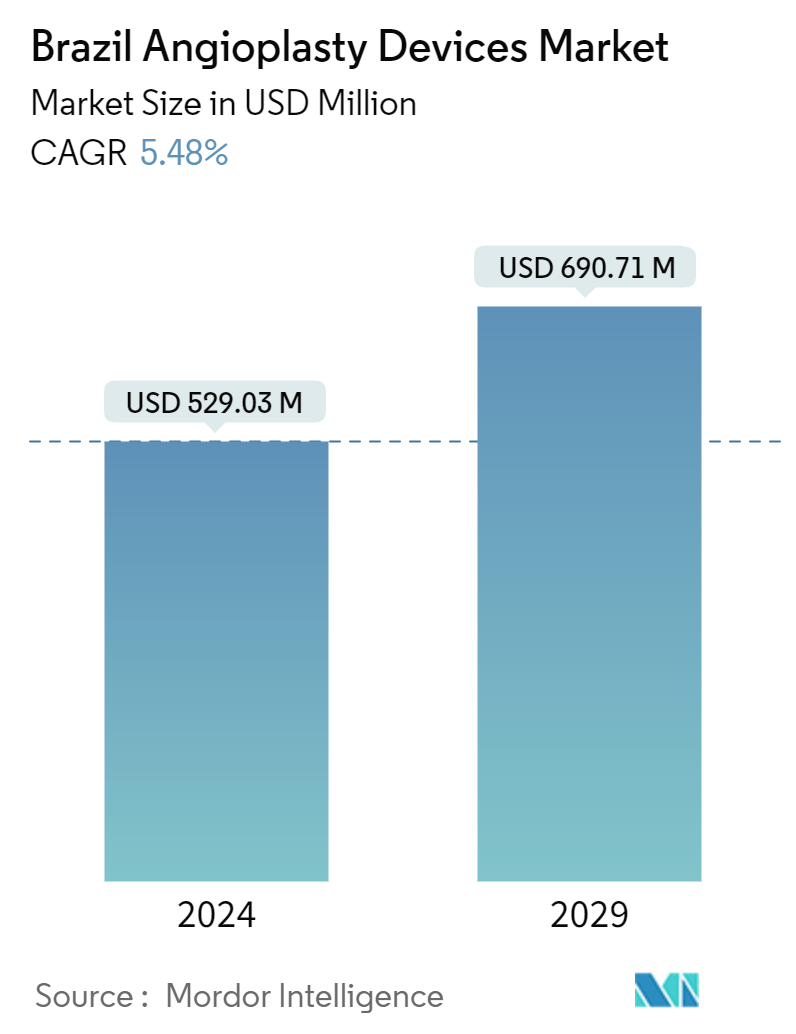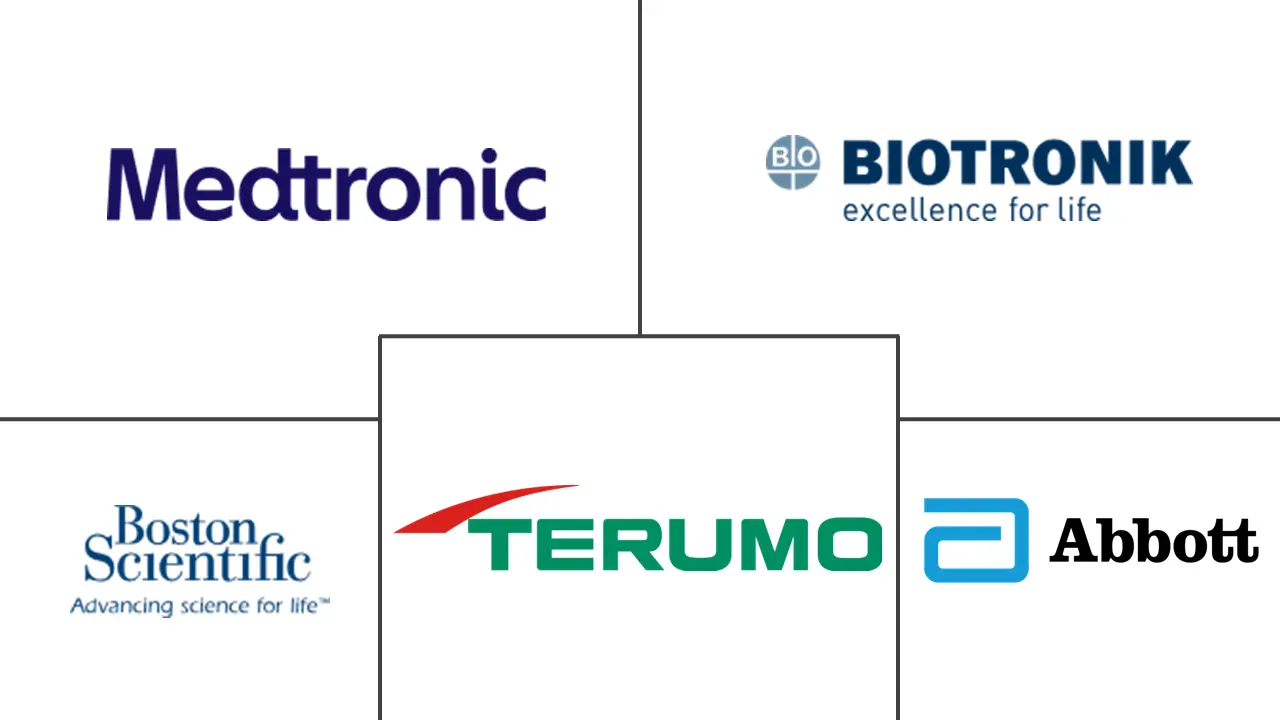Market Size of Brazil Angioplasty Devices Industry

| Study Period | 2019 - 2029 |
| Base Year For Estimation | 2023 |
| Market Size (2024) | USD 529.03 Million |
| Market Size (2029) | USD 690.71 Million |
| CAGR (2024 - 2029) | 5.48 % |
| Market Concentration | Medium |
Major Players
*Disclaimer: Major Players sorted in no particular order |
Brazil Angioplasty Devices Market Analysis
The Brazil Angioplasty Devices Market size is estimated at USD 529.03 million in 2024, and is expected to reach USD 690.71 million by 2029, growing at a CAGR of 5.48% during the forecast period (2024-2029).
Angioplasty is a procedure performed to open blocked coronary arteries using medical devices such as stents, sheaths, guidewires, balloon catheters, and imaging equipment. The increasing burden of cardiovascular diseases in Brazil is significantly driving the demand for minimally invasive procedures like angioplasty.
The rise in cardiovascular diseases is closely linked to common risk factors such as hypertension, diabetes, obesity, unhealthy diet, physical inactivity, and smoking. The increasing urbanization and lifestyle changes in Brazil have led to higher exposure to these risk factors, contributing to the growing burden of cardiovascular diseases. For instance, according to Arquivos Brasileiros de Cardiologia, in 2022, Brazil recorded a significant number of hospitalizations due to cardiovascular diseases (CVDs). The country saw a total of 1.29 million hospital admissions related to cardiovascular conditions. This reflects the substantial burden of CVDs on the Brazilian healthcare system and underscores the critical need for effective prevention and management strategies to address this public health challenge.
Brazil's aging population is another crucial factor in increasing the prevalence of cardiovascular diseases. As the population ages, the incidence of age-related diseases like CVD naturally rises. The proportion of elderly individuals in Brazil is growing, leading to a higher prevalence of heart diseases. For instance, according to the 2022 Census, Brazil had over 22.2 million older persons aged 65 years and older, 10.9% of the country's population. This age group is expected to reach approximately 50 million, representing 24% of the Brazilian population by 2030.
Moreover, technological advancements are also playing a crucial role in driving market growth. Innovations in medical devices and techniques, such as drug-eluting balloons and advanced vascular imaging technologies, have improved the efficacy and safety of angioplasty procedures. Major medical device companies are investing in and expanding their product offerings in Brazil, further promoting the adoption of these minimally invasive techniques. For instance, in September 2023, the Reewarm PTX Drug-Coated Balloon (DCB) Catheter, developed by Endovastec, was successfully implanted for the first time in Brazil. Drug-coated balloons (DCBs) are increasingly used because of their potential to combine balloon angioplasty and antiproliferative drug elution without leaving a permanent metal implant that may distort and constrain the coronary vessel, limit vasomotion and adaptive remodeling, and promote chronic inflammation. Such developments in angioplasty are expected to surge the adoption rate of these devices, subsequently boosting market growth.
Therefore, the increasing geriatric population and increasing preference toward minimally invasive procedures, coupled with continuous technological advancement by market players, are some of the factors positioning the angioplasty devices market in Brazil for substantial growth as it adapts to the rising healthcare needs driven by the burden of cardiovascular diseases.
However, the high costs associated with this procedure and the risk of complications, leading to a surge in the economic burden on the patient population, may serve as an impediment to limiting the market's growth.
Brazil Angioplasty Devices Industry Segmentation
As per the scope of the report, angioplasty is a medical procedure used to widen narrowed or blocked blood vessels, typically arteries. Angioplasty is commonly used to treat conditions like coronary artery disease and peripheral artery disease. Devices such as stents, balloons, and guidewires are most commonly used during this procedure. The Brazilian angioplasty devices market is segmented by product type (stents, guidewires, balloons, and other product types), application (coronary angioplasty and peripheral angioplasty), and end user (hospitals, specialty clinics, and other end users). The report offers the value (USD) for all the above segments.
| By Product Type | |
| Stents | |
| Guidewires | |
| Balloons | |
| Other Product Types |
| By Application | |
| Coronary Angioplasty | |
| Peripheral Angioplasty |
| By End User | |
| Hospitals | |
| Specialty Clinics | |
| Other End Users |
Brazil Angioplasty Devices Market Size Summary
The Brazilian angioplasty devices market is poised for substantial growth, driven by the increasing prevalence of cardiovascular diseases and the aging population. The demand for minimally invasive procedures like angioplasty is on the rise, fueled by lifestyle changes and urbanization that have heightened exposure to risk factors such as hypertension, diabetes, and obesity. Technological advancements in medical devices, including drug-eluting balloons and advanced vascular imaging technologies, are enhancing the efficacy and safety of angioplasty procedures. Major medical device companies are expanding their product offerings in Brazil, promoting the adoption of these techniques. The market is characterized by a strong presence of established players, with significant contributions from international companies like Boston Scientific Corporation, Medtronic, and Abbott Laboratories.
The angioplasty stents segment is expected to experience significant growth due to the greater adoption of stent procedures and the high burden of cardiology emergency cases, particularly among the geriatric population. The availability of new products and approvals, such as the ABRE Stent for Deep Vein Thrombosis, is further boosting segment growth. Coronary angioplasty, aimed at addressing coronary artery disease, is also set to grow, supported by rising obesity rates and increased awareness of heart conditions. Initiatives promoting early diagnosis and affordable cardiovascular healthcare services are contributing to the segment's expansion. Overall, the market is adapting to the rising healthcare needs driven by cardiovascular diseases, with continuous technological advancements and a focus on minimally invasive procedures.
Brazil Angioplasty Devices Market Size - Table of Contents
-
1. MARKET DYNAMICS
-
1.1 Market Overview
-
1.2 Market Drivers
-
1.2.1 Increasing Burden of Cardiovascular Diseases Requiring Angioplasty
-
1.2.2 Increasing Preference for Minimally Invasive Procedures and Technological Advancements
-
-
1.3 Market Restraints
-
1.3.1 High Costs Associated with the Procedure and Risk of Complications
-
-
1.4 Porter's Five Force Analysis
-
1.4.1 Threat of New Entrants
-
1.4.2 Bargaining Power of Buyers/Consumers
-
1.4.3 Bargaining Power of Suppliers
-
1.4.4 Threat of Substitute Products
-
1.4.5 Intensity of Competitive Rivalry
-
-
-
2. MARKET SEGMENTATION (Market Size by Value - USD)
-
2.1 By Product Type
-
2.1.1 Stents
-
2.1.2 Guidewires
-
2.1.3 Balloons
-
2.1.4 Other Product Types
-
-
2.2 By Application
-
2.2.1 Coronary Angioplasty
-
2.2.2 Peripheral Angioplasty
-
-
2.3 By End User
-
2.3.1 Hospitals
-
2.3.2 Specialty Clinics
-
2.3.3 Other End Users
-
-
Brazil Angioplasty Devices Market Size FAQs
How big is the Brazil Angioplasty Devices Market?
The Brazil Angioplasty Devices Market size is expected to reach USD 529.03 million in 2024 and grow at a CAGR of 5.48% to reach USD 690.71 million by 2029.
What is the current Brazil Angioplasty Devices Market size?
In 2024, the Brazil Angioplasty Devices Market size is expected to reach USD 529.03 million.

